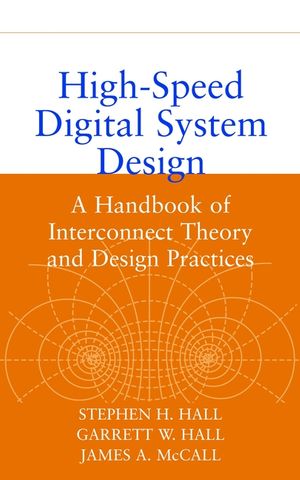High-Speed Digital System Design: A Handbook of Interconnect Theory and Design PracticesISBN: 978-0-471-36090-2
Hardcover
362 pages
September 2000, Wiley-IEEE Press
 This is a Print-on-Demand title. It will be printed specifically to fill your order. Please allow an additional 10-15 days delivery time. The book is not returnable.
|
||||||
A cutting-edge guide to the theory and practice of high-speed
digital system design
An understanding of high-speed interconnect phenomena is essential for digital designers who must deal with the challenges posed by the ever-increasing operating speeds of today's microprocessors. This book provides a much-needed, practical guide to the state of the art of modern digital system design, combining easily accessible explanations with immensely useful problem-solving strategies. Written by three leading Intel engineers, High-Speed Digital System Design clarifies difficult and often neglected topics involving the effects of high frequencies on digital buses and presents a variety of proven techniques and application examples. Extensive appendices, formulas, modeling techniques as well as hundreds of figures are also provided.
Coverage includes:
* A thorough introduction to the digital aspects of basic transmission line theory
* Crosstalk and nonideal transmission line effects on signal quality and timings
* The impact of packages, vias, and connectors on signal integrity
* The effects of nonideal return current paths, high frequency power delivery, and simultaneous switching noise
* Explanations of how driving circuit characteristics affect the quality of the digital signal
* Digital timing analysis at the system level that incorporates high-speed signaling effects into timing budgets
* Methodologies for designing high-speed buses and handling the very large number of variables that affect interconnect performance
* Radiated emission problems and how to minimize system noise
* The practical aspects of making measurements in high-speed digital systems
An understanding of high-speed interconnect phenomena is essential for digital designers who must deal with the challenges posed by the ever-increasing operating speeds of today's microprocessors. This book provides a much-needed, practical guide to the state of the art of modern digital system design, combining easily accessible explanations with immensely useful problem-solving strategies. Written by three leading Intel engineers, High-Speed Digital System Design clarifies difficult and often neglected topics involving the effects of high frequencies on digital buses and presents a variety of proven techniques and application examples. Extensive appendices, formulas, modeling techniques as well as hundreds of figures are also provided.
Coverage includes:
* A thorough introduction to the digital aspects of basic transmission line theory
* Crosstalk and nonideal transmission line effects on signal quality and timings
* The impact of packages, vias, and connectors on signal integrity
* The effects of nonideal return current paths, high frequency power delivery, and simultaneous switching noise
* Explanations of how driving circuit characteristics affect the quality of the digital signal
* Digital timing analysis at the system level that incorporates high-speed signaling effects into timing budgets
* Methodologies for designing high-speed buses and handling the very large number of variables that affect interconnect performance
* Radiated emission problems and how to minimize system noise
* The practical aspects of making measurements in high-speed digital systems



